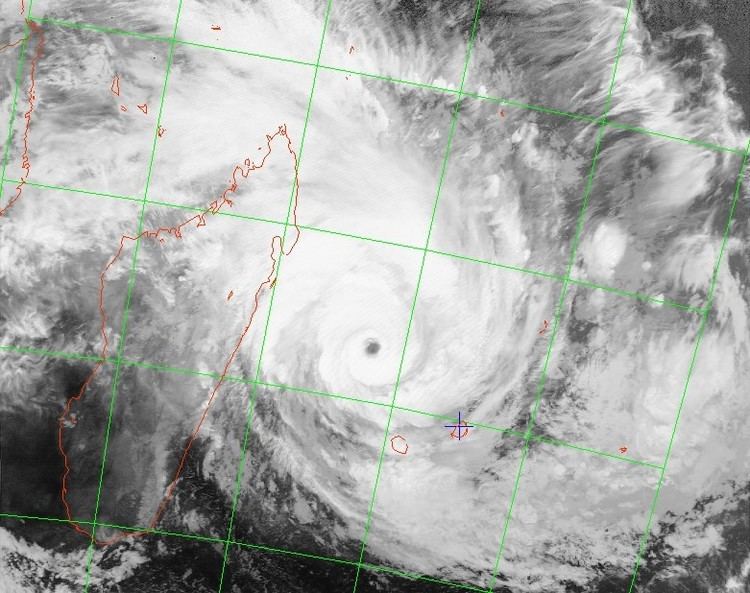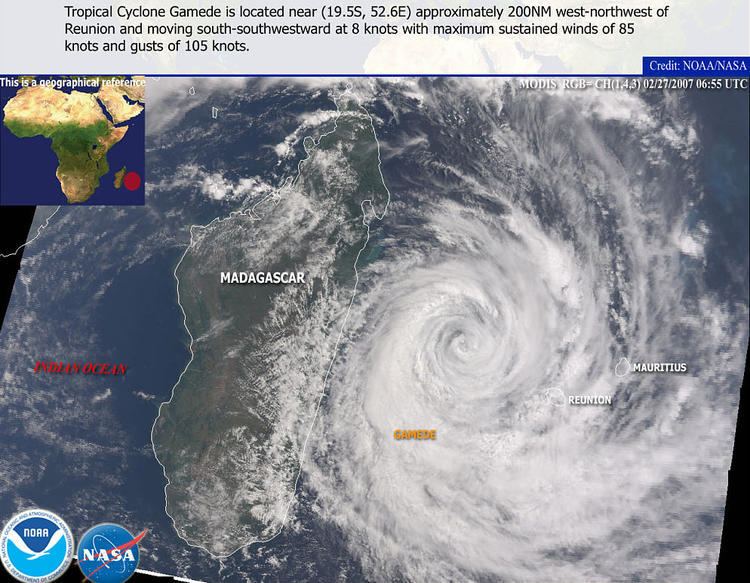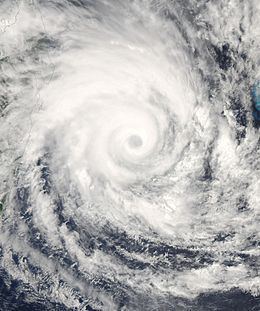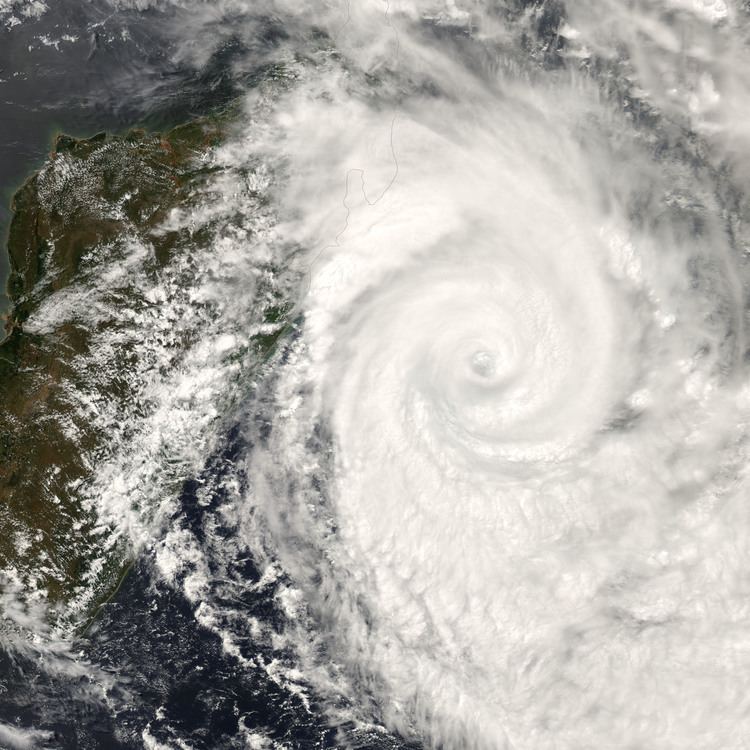Fatalities 4 direct | Damage $26 million (2007 USD) | |
 | ||
Formed February 20, 2007 (2007-02-20) Dissipated March 3, 2007 (2007-03-04) Highest winds 10-minute sustained: 165 km/h (105 mph)1-minute sustained: 195 km/h (120 mph)Gusts: 230 km/h (145 mph) Lowest pressure 935 hPa (mbar); 27.61 inHg Date 20 February 2007 – 3 March 2007 Similar Cyclone Dina, Cyclone Bejisa, Cyclone Firinga, Cyclone Hyacinthe, Cyclone Favio | ||
Tropical cyclone gamede 24 feb 2007
Cyclone Gamede was among the wettest tropical cyclones on record, dropping more than 5.5 m (18 ft) of rain in a nine-day period on Réunion island in the southwest Indian Ocean. The seventh named storm of the 2006–07 South-West Indian Ocean cyclone season, Gamede formed on February 20 as a tropical depression to the south of Diego Garcia. It tracked generally westward and steadily intensified, passing northwest of Mauritius and Réunion as a broad but moderately intense tropical cyclone. For four days it remained within 400 km (250 mi) of Réunion before accelerating southward, and on March 3 Gamede transitioned into an extratropical cyclone to the south of Madagascar.
Contents
- Tropical cyclone gamede 24 feb 2007
- Cyclone gamede a la reunion
- Meteorological history
- Preparations
- Impact and records
- References

Gamede broke rainfall records set by Cyclone Hyacinthe 27 years earlier for the accumulated totals between three and nine days. The rainfall caused moderate damage in Réunion, and in the southern portion of the island a bridge collapsed due to the storm. Two people each were killed on Mauritius and Réunion. The name Gamede was submitted to the World Meteorological Organization by South Africa.

Cyclone gamede a la reunion
Meteorological history

On February 19, an area of convection persisted over a weak, but well-defined low-level circulation about 1130 km (700 mi) southeast of Diego Garcia. It quickly developed banding features, and organized into a tropical disturbance. Located beneath an anticyclone, the system experienced weak vertical wind shear and favorable outflow. With a subtropical ridge to its south, the disturbance tracked quickly westward. Early on February 20, Météo-France (MFR) classified the system as Tropical Depression Ten, and later in the day the Joint Typhoon Warning Center (JTWC) issued a Tropical Cyclone Formation Alert as the convection improved significantly in organization. It strengthened further, attaining tropical storm status by 0000 UTC on February 21, and six hours later the MFR named the system Gamede while it was about 785 km (490 mi) south-southwest of Diego Garcia, or about 995 km (620 mi) northeast of Rodrigues.

After being named, Gamede quickly intensified, and the JTWC classified it with winds of 120 km/h (75 mph) early on February 22. As it turned west-southwestward, an eye feature became evident on satellite imagery, and the JTWC upgraded Gamede to tropical cyclone status, or the equivalence of a minimal hurricane. Subsequently, its intensification rate slowed somewhat, due to restricted outflow. At 0000 UTC on February 23 the MFR upgraded the storm to Tropical Cyclone Gamede, and shortly thereafter it passed over St. Brandon island. Subsequently, outflow became better established, and the JTWC unofficially estimated the cyclone attained winds of 185 km/h (115 mph) late on February 23 about 250 km (400 mi) north-northeast of Mauritius island. Initially it was forecast to strengthen further, though slight weakening occurred when a nearby upper-level trough restricted outflow.

Cyclone Gamede remained a broad system, and by February 24 it produced winds of near gale force up to 670 km (415 mi) southeast of its center; later in the day, it passed about 300 km (190 mi) north of Réunion, its closest point of approach to the island. For over 90 hours, the cyclone remained within 400 km (250 mi) of the island, resulting in torrential rainfall in the island's mountainous region. Radar imagery on the island indicated Gamede maintained an eye diameter of 60–70 km (37–43 mi). After tracking generally southwestward for several days, a building ridge to its south changed the motion of the cyclone to the west before it became quasi-stationary. Initially, it was predicted to continue westward and strike Madagascar near Toamasina. The cyclone re-intensified while executing a small loop, and late on February 25 Gamede officially attained peak winds of 165 km/h (105 mph) about halfway between Réunion island and the coast of Madagascar; at the time, wind gusts in association with the storm reached 230 km/h (135 mph).
The cyclone weakened while remaining nearly stationary, losing most of its deep convection due to upwelling; this is the process in which a stationary storm causes the water temperatures to decrease by bringing the cooler, deeper waters to the surface. It remained nearly stationary until beginning a steady south-southwestward motion late on February 26, a change due to an approaching mid-level trough to its south. On February 28, convection increased around a rebuilding eyewall as it accelerated southward, though on March 1 the cyclone again weakened as wind shear increased and as water temperatures gradually decreased. Gamede weakened to tropical storm status as its center became exposed from the deep convection, and late on March 1 it transitioned into an extratropical cyclone. After completing the transition, the storm became nearly stationary for about two days, during which its winds decreased to below gale force. The remnants of Gamede turned westward and persisted until dissipating on March 6.
Preparations
In Mauritius, a total of 200 people evacuated to storm shelters due to the cyclone. The island was under a Cyclone Warning Class III for 36 hours, and for a few more hours it was under a Cyclone Warning Class IV, the latter meaning wind gusts of 120 km/h (75 mph) were reported or expected. Prior to the storm affecting the area, officials in Réunion closed schools and also issued a temporary driving ban. Due to the threat of the storm, several flights in and out of Mauritius, Réunion, and Rodrigues were canceled. Fishermen were banned from sailing out to sea.
Impact and records
On midday February 23, Cyclone Gamede moved over St. Brandon island, where a pressure of 960 mbar was recorded.
The cyclone affected the country of Mauritius on February 25. Power was knocked out to 70% of the island's population, and some light infrastructure damage was also reported. Food crops were also affected. Despite warnings to remain inside, several people ventured outside during the storm. Gamede killed two on Mauritius, including one who drowned in high waves.
The large size of the cyclone resulted in several days of very heavy, continuous rainfall in the mountainous region on Réunion island. The island is the location for several tropical cyclone rainfall records; due to the orography of the island, tropical moisture will travel upward to the volcanic peaks, where it cools and codifies into rainfall. The heaviest totals occurred from February 24 through February 28. Commerson's Crater, located at an elevation of 2.3 km (1.4 mi), reported 2463 mm (97 in) in 48 hours, which is just short of the worldwide record set by an unnamed tropical cyclone in April 1958. Gamede broke worldwide rainfall records between three and nine days, with its total precipitation amounting to 5512 mm (217 in) in Commerson's Crater; Cyclone Hyacinthe in 1980 remains the wettest tropical cyclone on record, having produced greater totals after ten days. Several locations on the island reported great totals. In a 24‑hour period, Hell-Bourg reported 1489 mm (58.6 in), and in a 72‑hour period, Cilaos reported 2321 mm (91.4 in).
The passage of the cyclone left about 100,000 homes without power or water on Réunion. The rainfall caused some flood damage, and the combination of precipitation and strong winds caused heavy crop damage, including to the sugar cane and banana crops. Several roads and bridges were damaged on the island. A 520 m (1700 ft) bridge over the Saint Etienne River collapsed near Saint-Louis, with the cost estimated at €20 million (2007 EUR, $26 million 2007 USD). The bridge, which carried about 50,000 vehicles per day, collapsed as river flow increased from the heavy rainfall; two towns were left temporarily isolated due to the incident. Two people died on the island after attempting to cross rivers during the storm. Nine people were injured on the island, including two who were seriously injured. A peak wind gust of 205 km/h (127 mph) was reported on the island. On June 13, 2007, the government of France provided a relief fund to Réunion of €17.6 million (2007 EUR) in aid, including €9.6 million for farmers affected by the cyclone. The assistance provided €7.7 million for repairing roads and infrastructure, including rebuilding the destroyed bridge over the Saint Etienne River. In the immediate aftermath of the storm, officials deployed army resources to establish a temporary aerial bridge while a new bridge was built.
Rough waves and strong winds affected a cruise ship to the east of Madagascar; several windows were broken, though no serious injuries were reported. Along Madagascar's east coast, Gamede produced squally rain and winds. Gamede had followed shortly after Tropical Cyclones Bondo, Clovis, and Favio, being the fourth tropical cyclone to impact Madagascar in two months.
